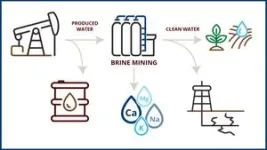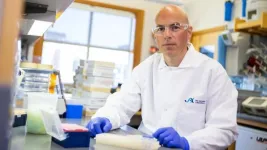(Press-News.org) In an ironic twist, a treasure trove of critical minerals is dumped out with water considered too polluted and expensive to clean.
Texas A&M University researcher Dr. Hamidreza Samouei is investigating the components of produced water and says this waste byproduct of oil and gas operations contains nearly every element in the periodic table, including those of significant interest to national economies.
His goal is to treat the water using unwanted carbon dioxide (CO2) in stages to recover these valuable elements and ultimately produce fresh water for agricultural use once the processes are complete.
“Recognizing the latent value within produced water can offer tangible solutions to some of the world’s most pressing environmental challenges, from CO2 emissions to the increasing scarcity of certain minerals and water itself,” said Samouei, a research assistant professor in the Harold Vance Department of Petroleum Engineering.
Samouei’s “brine mining” research was featured in a January 2024 article in the Society of Petroleum Engineers’ Journal of Petroleum Technology titled “Liquid Goldmine: unlocking the Critical Mineral Potential of Produced Water using Carbon Dioxide.” He introduced the topic at the Middle East Water Week Conference and Exhibition held December 2023 in Saudi Arabia and will report his most recent discoveries at the Annual Produced Water Society Conference on February 2024 in Houston, Texas.
Why is produced water thrown away?
Water accumulates in subsurface areas where geological functions happen, like hydrocarbon reservoirs, and it dissolves and stores vast quantities of minerals and other elements. During oil and gas operations, an average of six 42-gallon barrels of this “produced” water are recovered for every one barrel of oil, and in rare cases, up to a staggering ratio of 500 to 1. It is up to 10 times saltier than seawater and contains about 6,000 times more minerals.
In 2020, the annual global quantity of produced water recovered from oil and gas operations surpassed 240 billion barrels, with Texas alone recovering 33 million barrels daily. The oilfields of the Permian Basin in Texas generate more produced water than all other U.S. shale plays combined. Treating this vast volume is cost-prohibitive, so produced water is mainly considered a waste product and injected in subsurface disposal fields for safe containment.
The hidden values in brine
Since everything in produced water has never been cataloged, Samouei’s research began with the basics. He collected produced water samples around the U.S. and created a standardized method of analyzing the water’s content. That’s when he learned it contained nearly everything listed in the periodic table of elements.
Samouei’s findings included critical minerals like lithium, rubidium, cesium, gallium and platinum group metals – substances fundamental to the current and future technologies advancing computer, energy and transportation industries. More importantly, like other brines, produced water featured less expensive but abundant quantities of sodium, potassium, magnesium and calcium – used in manufacturing processes, fertilizer production and other industries.
All these minerals can be far more lucrative than the oil that comes up with produced water, so water reclamation costs could be easily offset by selling the recovered minerals.
A better treatment
Samouei explained that while desalinating produced water has been considered, the approach of first mining all the salt and minerals before treating the water had not been explored.
Much of his current research centers on developing the best flow of methods for extracting valuable minerals from brine in stages of refinement using CO2 desalination, which he says is “a groundbreaking approach to targeted mineral recovery from produced water.” The process includes a variety of filtration techniques, such as ultrafiltration and nanofiltration, and even utilizes reverse osmosis.
Commercialization potential
The research is creating a baseline for brine mining, whether using produced water or other brackish sources, but Samouei said further development would need a funding source. Government sponsors are concentrating on critical mineral mining in places such as the sea floor or even asteroids, not on something as close to home as produced water.
Samouei said he hopes to change the oil and gas industry's view of produced water, first to see it as a lucrative means of receiving money and later, perhaps in 10 years, as a source for their own mining operations.
“Produced water may not be beautiful if we look at it as a waste,” he said, “but it will be impactful to the world’s next generations if we look at it as a resource.”
END
Mining the treasures locked away in produced water
2024-03-01
ELSE PRESS RELEASES FROM THIS DATE:
Minoritized groups face high anxiety when taking part in research experiments
2024-03-01
RIVERSIDE, Calif. -- When participating in research studies, moderately anxious or highly anxious children from minoritized groups are likely to be hypervigilant to threat, further compounding the effects of their general state of anxiety, a research study led by a University of California, Riverside, psychologist reports.
The study, which involved the participation of 46 Inland Southern California preadolescent Latina girls (8–13 years), has implications also for children from families with low socioeconomic status.
“Psychological research is often conducted in white, educated, and affluent communities,” said Kalina Michalska, ...
Orcas demonstrating they no longer need to hunt in packs to take down the great white shark
2024-03-01
An orca (killer whale) has been observed, for the first-ever time, individually consuming a great white shark – and within just two minutes.
“The astonishing predation, off the coast of Mossel Bay, South Africa, represents unprecedented behavior underscoring the exceptional proficiency of the killer whale”, remarks Dr. Alison Towner from Rhodes University, who led an international research team into the discovery.
Their findings are published today in the peer-reviewed African Journal of Marine Science.
The groundbreaking insight is the latest from Dr. Towner and the team, who, in 2022 in the same journal, ...
Scientists discover a novel vehicle for antibiotic resistance
2024-03-01
By David L. Chandler
WOODS HOLE, Mass. -- Antibiotic resistance is a significant and growing medical problem worldwide. Researchers at the Marine Biological Laboratory (MBL) and collaborators have found a novel genetic arrangement that may help a common bacterium in the human gut, Bacteroides fragilis, protect itself from tetracycline, a widely used antibiotic.
While these findings will not lead directly to new ways of combating tetracycline-resistant bacteria, the researchers have discovered previously unseen genetic arrangements that confer antibiotic resistance. Such understanding might help in developing new ways to limit the spread of antibiotic resistance genes, through genetic ...
Large-scale study explores link between smoking and DNA changes across six racial and ethnic groups
2024-03-01
Smoking changes the way genes are expressed, which later contributes to the development of lung cancer and other smoking-related illnesses. But the link between epigenetics (the study of mechanisms that impact gene expression) and smoking is not fully understood, especially in terms of differences across racial and ethnic groups.
“We know that smoking affects people differently based on their race and ethnicity, but identifying epigenetic signatures of smoking would help us better predict risk for smoking-related diseases,” said Brian Huang, PhD, an assistant professor in the department of population ...
EU funding for outstanding early-career researcher Pieter Gunnink
2024-03-01
Dr. Pieter Gunnink from the Institute of Physics at Johannes Gutenberg University Mainz (JGU) has been awarded a EUR 190,000 Marie Skłodowska-Curie Postdoctoral Fellowship by the European Commission. The grant is an individual award for Gunnink's outstanding achievements in the field of spintronics and provides financial support for his research over a period of 24 months.
Modern information processing relies heavily on the use of electrical current, the transport of which requires large amounts of energy. The field of ...
Associate Professor Ron Korstanje, Ph.D., of The Jackson Laboratory named Evnin Family Chair
2024-03-01
Associate Professor Ron Korstanje, Ph.D., has been named the Evnin Family Chair at The Jackson Laboratory. An expert in the genetics of kidney function and disease, Korstanje’s appointment marks a new chapter in his 20 years of service to JAX’s mission.
“Ron’s exceptional contributions to JAX have advanced research discoveries and nurtured generations of future scientists,” said President and CEO Lon Cardon, Ph.D., FMedSci. “His appointment as the Evnin Family ...
Researchers create coating solution for safer food storage
2024-03-01
In a collaborative effort to improve the food industry, Dr. Mustafa Akbulut, professor of chemical engineering, and Dr. Luis Cisneros-Zevallos, professor of horticultural science, have developed a two-step coating solution for galvanized steel that is more hygienic and reduces the risk of corrosion.
Galvanized steel containers and surfaces are used for harvested produce because of their durability, strength and lower cost compared to stainless steel. However, bacteria residing in storage containers can cause corrosion.
The ...
An overgrowth of nerve cells appears to cause lingering symptoms after recurrent UTIs
2024-03-01
DURHAM, N.C. – A perplexing problem for people with recurring urinary tract infections (UTIs) is persistent pain, even after antibiotics have successfully cleared the bacteria.
Now Duke Health researchers have identified the likely cause - an overgrowth of nerve cells in the bladder.
The finding, appearing March 1 in the journal Science Immunology, provides a potential new approach to managing symptoms of recurring UTIs that would more effectively target the problem and reduce unnecessary antibiotic usage.
“Urinary tract infections account for almost 25% of infections in women,” said senior author Soman Abraham, Ph.D., professor in the departments ...
New findings on the immune system
2024-03-01
T follicular helper cells (Tfh) are essential for strong antibody-mediated reactions of our immune system during infections and vaccinations. However, if they get out of control, this can cause diseases such as autoimmunity, allergies or cancer. Researchers from the University Hospital Bonn (UKB) and the Cluster of Excellence ImmunoSensation2 at the University of Bonn investigated the underlying mechanisms of Tfh cell development in a mouse model and thus decoded their internal networking. They hope that this will lead to new strategies for the development of highly effective vaccines and new therapies to combat various diseases. The results have ...
Most smokers in England wrongly believe vaping is at least as harmful as smoking
2024-03-01
More than half of smokers in England wrongly believe that vaping is more harmful or as harmful as smoking, according to a new study led by UCL (University College London) researchers.
The study, published in the journal JAMA Network Open and funded by Cancer Research UK, looked at survey responses from 28,393 smokers in England between 2014 and 2023.
The research team found that public perceptions of e-cigarettes had worsened considerably over the past decade, with an overall increase in the perceived harm of e-cigarettes since 2021, coinciding with a sharp rise in vaping among young ...







